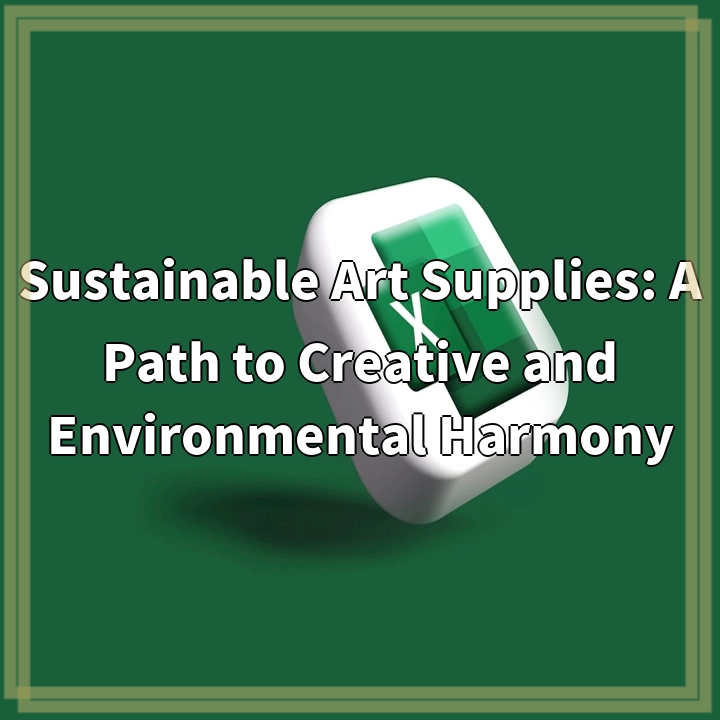Physical Address
304 North Cardinal St.
Dorchester Center, MA 02124
Physical Address
304 North Cardinal St.
Dorchester Center, MA 02124

Artists around the world are embracing sustainable art supplies as a way to minimize their negative impact on the environment. These materials and tools are designed and produced using methods that prioritize ecological balance, resource conservation, and social responsibility. By opting for sustainable art supplies, artists can contribute to a more sustainable and environmentally friendly creative practice.
While art is a vibrant and expressive form of human creativity, it is not without its environmental drawbacks. The production and use of traditional art supplies can often contribute to pollution, waste generation, and resource depletion. Here are some of the real-world problems associated with conventional art supplies:
Many traditional art supplies contain toxic chemicals that can be harmful to human health and the environment. Paints, solvents, and markers often contain high levels of volatile organic compounds (VOCs) and heavy metals, which can contaminate air and water sources when disposed of improperly.
Artistic endeavors can result in significant waste generation, including packaging materials, disposable brushes, and single-use palettes. This waste, if not properly managed, can end up in landfills or contribute to litter that harms wildlife and ecosystems.
The production of traditional art supplies relies on the extraction of natural resources, such as oil for paints and wood for canvases. Unsustainable sourcing practices can lead to habitat destruction, loss of biodiversity, and land degradation.
The manufacturing processes involved in creating conventional art supplies often require substantial amounts of energy, contributing to greenhouse gas emissions and climate change. This energy-intensive production cycle further exacerbates environmental impacts.
Artists may unknowingly use art supplies that are manufactured without regard for sustainability or ethical practices. Without proper labeling or transparency from manufacturers, it can be challenging for artists to make informed choices about the environmental impact of the supplies they are using.
One of the barriers to adopting sustainable art supplies is the perception that they are more expensive compared to conventional alternatives. This can make it challenging for artists on a limited budget to switch to more environmentally friendly options.
Fortunately, there are practical solutions available for artists who want to embrace sustainable art supplies:
Choose art supplies that are labeled as non-toxic, low in VOCs, and free from heavy metals. Water-based paints, natural pigments, and eco-friendly solvents are all viable options that minimize chemical pollution.
Artists can minimize waste generation by using reusable palettes, investing in quality brushes and tools that can be maintained and reused, and responsibly disposing of any hazardous materials. Recycling and upcycling art materials can also help reduce the overall waste footprint.
Look for art supplies made from sustainably sourced materials. Opt for recycled or FSC-certified paper, canvas made from organic or recycled fibers, and brushes made from sustainable materials such as bamboo or synthetic alternatives.
Research and choose art supply brands that prioritize sustainability, transparency, and ethical practices. Support companies that disclose their manufacturing processes, use eco-friendly materials, and actively work to reduce their environmental impact.
Artists can use their platforms and influence to educate others about the importance of sustainable art supplies. By raising awareness and advocating for change, artists can encourage the industry to prioritize environmental considerations in their product offerings.
Consider creating your own art supplies using natural and readily available materials. This could include making paints from vegetable pigments, using natural dyes, or experimenting with recycled or repurposed items for unique textures and effects.
Connect with other artists and organizations that are committed to sustainability. By sharing resources, knowledge, and experiences, artists can collectively work towards finding innovative and eco-friendly solutions for art creation.
By embracing sustainable art supplies, artists can not only create beautiful and meaningful works of art but also contribute to a more sustainable and environmentally conscious world.
If you’re wondering where the article came from!
#